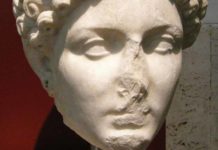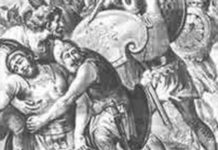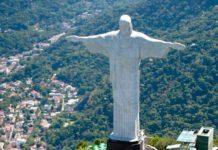On August 24, 79 A.D., a small town in the Roman province of Campania, on the western shore of Italy, was stopped dead in her tracks by the violent eruption of Mt. Vesuvius. The city, Pompeii, along with her sister city Herculaneum, were buried beneath several feet of ash and mud, forever memorializing the towns and their people. It wasn’t until Pompeii was again discovered in the mid 18th century that the world was able to discover this town, and it inner workings. Not only did the discovery and subsequent excavations at Pompeii uncover a city frozen in time, but it also provided a wealth of information for scholars about the various aspects of Roman life, politics, art, and society. Pompeii was literally an open book to be studied.
Pompeii was a small town that had been occupied by several Italian tribes over the years, including the Oscans and the Etruscans. In 80 B.C., Roman general Sulla came through and colonized the town with Roman soldiers, and gave the town status as a Roman city. Pompeii was sort of like a smaller version of Rome, with similar government operations. It was also responsible for its own domestic policies and issues. Rome didn’t interfere with Pompeii’s dealing much, but it was subject to the same Imperial decrees that other Roman cities were.
Over the years, Pompeii prospered as a city of industry, farming grapes from the fertile hillsides of Mt. Vesuvius for wine, and also operating two major food industries: the production of bread and garum, or fish sauce. There was also a thriving wool industry in Pompeii. The successes of Pompeii industrial pursuits made Pompeii a rather wealthy town, and its architecture showcased this wealth, with such structures as the Villa of the Mysteries, the House of the Vettii, the Building of Eumachia, and the Temple of the Capitoline Triad. Pompeii was also appointed with all of the buildings found in any respectable Roman city, such as an amphitheater and an odeion.
On February 5, 62 A.D., the prosperity and contentment of this verdant coastal town was cut short when a violent earthquake struck and caused major damage to most of Pompeii’s buildings and homes. Unaware that this quake was likely a sign of something worse to come, the Pompeiians began rebuilding their city. Alas, this was all for naught. In the early morning hours of August 24, 79 A.D., Mt. Vesuvius, the mountain that had been the source of Pompeii’s prosperity, blew its top and spewed hot ash and gases several miles into the air. The crater left behind from that eruption is still visible today.
The people of Pompeii had little time to escape, but they did try. Many people tried to protect themselves in their homes, and many tried to flee. The people of Herculaneum, which was rights on the coast, began fleeing into the ocean. Unfortunately, the hot gases and ash overcame them, and many people suffocated or were buried alive. For several hours that day, ash rained down on Pompeii, and a violent surge of mud slowly buried Herculaneum. The casts that were made by 20th century archaeologists of the people, frozen in their moments of death, are a haunting reminder of what Mother Nature can do.
The ruins of Pompeii have provided a unique opportunity for archaeologists that they rarely get. They are able to study every aspect of Roman society, through human remains, architectural ruins, graffito, and even through the foods that were left in situ. It is a fascinating chance to understand the inner workings of the Roman Empire, but the fact that so many humans lost their lives on the fateful day should not be forgotten or discounted.
Sources:
- Etienne, Robert. Pompeii: The Day a City Died. 1992, Abrams, Inc.
- Stambaugh, John E. The Ancient Roman City. 1988, The Johns Hopkins University Press.








